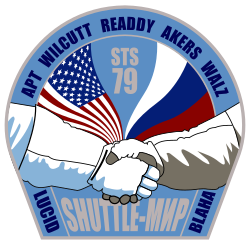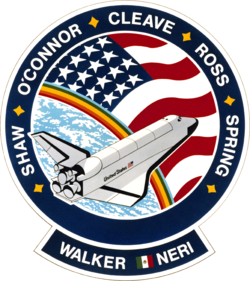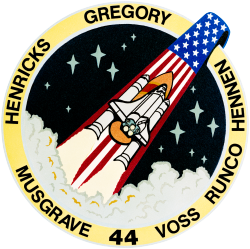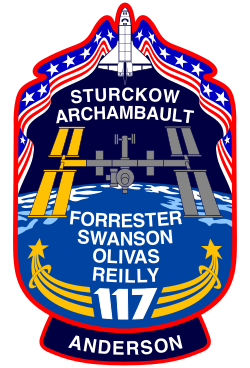Atlantis (Raumfähre)
 | |
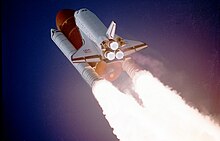 | |
 | |
 |
Die Raumfähre Atlantis ist ein Space Shuttle der NASA. Benannt nach dem ersten amerikanischen ozeanografischen Forschungsschiff Atlantis, wurde sie im April 1984 fertiggestellt und hatte ihren Jungfernflug im Oktober 1985 (STS-51-J). Die interne Bezeichnung des Orbiters lautet OV-104. Ihre letzte Mission endete am 21. Juli 2011.
Geschichte
Von 1995 bis 1997 wurde die Atlantis ausschließlich für die Flüge zur russischen Raumstation Mir im Rahmen des Shuttle-Mir-Programms eingesetzt, wofür sie mit einem Kopplungsadapter russischer Bauart ausgestattet wurde.
Am 8. Juli 2011 startete sie zu ihrer 33. und letzten Mission, welche auch die letzte Mission des Space-Shuttle-Programms war. Sie transportierte Proviant, Material und Technik für Experimente zur ISS und brachte das Logistikmodul Raffaello zur Erde zurück.[1] Am 21. Juli 2011 pünktlich um 11.57 MESZ setzte sie sicher auf der Landebahn 15 des Kennedy Space Centers in Florida (USA) auf.[2] Ihre Landung beendete die Ära der Shuttleflüge. Das Programm kostete zuletzt etwa 775 Millionen Dollar pro Mission.[3]
Seit dem Ende des amerikanischen Shuttle-Programms wird die Raumfähre als Museumsstück im Besucherzentrum des Kennedy Space Centers in Florida ausgestellt.[4]
Insgesamt hat die Atlantis in ihren 25 Dienstjahren mehr als 193 Millionen Kilometer zurückgelegt.[5]
Konstruktion
Die Atlantis profitierte von den Erfahrungen, die man beim Bau und Testen der Enterprise, Columbia und Challenger gemacht hatte. Bei der Fertigstellung wog sie rund 3.200 Kilogramm weniger als die Columbia. Außerdem verringerten die gemachten Erfahrungen im Shuttle-Bau die Arbeitsstunden um 49,5 Prozent (im Vergleich zur Columbia). Das ist vor allem auf die Nutzung von Hitzeschild-Decken am oberen Teil des Orbiters anstatt von kleinen Kacheln zurückzuführen.
Während der Konstruktion der Discovery und der Atlantis entschied sich die NASA dazu, „strukturelle Ersatzteile“ anfertigen zu lassen, um die Reparatur im Falle eines Unfalls zu erleichtern. Der Vertrag hatte insgesamt einen Wert von 389 Millionen Dollar und bestand aus Ersatzteilen für den hinteren und den mittleren Rumpf, sowie vordere Rumpfhälften, vertikale Ruder, Flügel und Klappen. Diese Ersatzteile wurden später für die Endeavour benutzt.
Zwischen November 1997 und Juli 1999 wurden in Palmdale, Kalifornien, an der Atlantis zahlreiche Verbesserungen und Anpassungen vorgenommen. Unter anderem wurde der Orbiter mit einem Bremsschirm und einem gläsernen Cockpit ausgestattet, es wurden neue Rohre und Verkabelungen installiert und über 800 Hitzeschutzkacheln und -decken ersetzt.
Missionen
| Nr. | Start | Bezeichnung | Emblem | Besatzung |
|---|---|---|---|---|
| 1 | 3. Oktober 1985 | STS-51-J | Karol Bobko, Ronald Grabe, David Hilmers, Robert Stewart, William Pailes | |
| 2 | 27. November 1985 | STS-61-B | Brewster Shaw, Bryan O’Connor, Mary Cleave, Sherwood Spring, Jerry Ross, Rodolfo Neri Vela, Charles Walker | |
| 3 | 2. Dezember 1988 | STS-27 | Robert Gibson, Guy Gardner, Richard Mullane, Jerry Ross, William Shepherd | |
| 4 | 4. Mai 1989 | STS-30 | David Walker, Ronald Grabe, Norman Thagard, Mary Cleave, Mark Lee | |
| 5 | 18. Oktober 1989 | STS-34 | Donald Williams, Michael McCulley, Franklin Chang-Diaz, Shannon Lucid, Ellen Baker | |
| 6 | 28. Februar 1990 | STS-36 | John Creighton, John Casper, Richard Mullane, David Hilmers, Pierre Thuot | |
| 7 | 15. November 1990 | STS-38 | Richard Covey, Frank Culbertson, Robert Springer, Carl Meade, Charles Gemar | |
| 8 | 5. April 1991 | STS-37 | Steven Nagel, Kenneth Cameron, Jerry Ross, Jerome Apt, Linda Godwin | |
| 9 | 2. August 1991 | STS-43 | John Blaha, Michael Baker, Shannon Lucid, James Adamson, David Low | |
| 10 | 24. November 1991 | STS-44 | Frederick Gregory, Terence Henricks, Story Musgrave, Mario Runco, James Voss, Thomas Hennen | |
| 11 | 24. März 1992 | STS-45 | Charles Bolden, Brian Duffy, Kathryn Sullivan, David Leestma, Michael Foale, Byron Lichtenberg, Dirk Frimout | |
| 12 | 31. Juli 1992 | STS-46 | Loren Shriver, Andrew Allen, Claude Nicollier, Jeffrey Hoffman, Franklin Chang-Diaz, Marsha Ivins, Franco Malerba | |
| 13 | 3. November 1994 | STS-66 | Donald McMonagle, Curtis Brown, Ellen Ochoa, Scott Parazynski, Joseph Tanner, Jean-François Clervoy | |
| 14 | 27. Juni 1995 | STS-71 | Robert Gibson, Charles Precourt, Ellen Baker, Bonnie Dunbar, Gregory Harbaugh | |
| 15 | 12. November 1995 | STS-74 | Kenneth Cameron, James Halsell, Jerry Ross, William S. McArthur, Chris Hadfield | |
| 16 | 22. März 1996 | STS-76 | Kevin Chilton, Richard Searfoss, Ronald Sega, Michael Clifford, Linda Godwin | |
| 17 | 16. September 1996 | STS-79 | William Readdy, Terrence Wilcutt, Thomas Akers, Jerome Apt, Carl Walz | |
| 18 | 12. Januar 1997 | STS-81 | Michael Baker, Brent Jett, John Grunsfeld, Marsha Ivins, Peter Wisoff | |
| 19 | 15. Mai 1997 | STS-84 | Charles Precourt, Eileen Collins, Carlos Noriega, Edward Lu, Jean-François Clervoy, Jelena Kondakowa | |
| 20 | 26. September 1997 | STS-86 | James Wetherbee, Michael Bloomfield, Wladimir Titow, Scott Parazynski, Jean-Loup Chrétien, Wendy Lawrence | |
| 21 | 19. Mai 2000 | STS-101 | James Halsell, Scott Horowitz, Jeffrey Williams, Susan Helms, James Voss, Mary Weber, Juri Ussatschow | |
| 22 | 8. September 2000 | STS-106 | Terence Wilcutt, Scott Altman, Daniel Burbank, Edward Lu, Juri Malentschenko, Richard Mastracchio, Boris Morukow | |
| 23 | 7. Februar 2001 | STS-98 | Kenneth Cockrell, Mark Polansky, Robert Curbeam, Marsha Ivins, Thomas Jones | |
| 24 | 12. Juli 2001 | STS-104 | Steven Lindsey, Charles Hobaugh, Michael Gernhardt, James Reilly, Janet Kavandi | |
| 25 | 8. April 2002 | STS-110 | Michael Bloomfield, Stephen Frick, Jerry Ross, Steven Smith, Ellen Ochoa, Lee Morin, Rex Walheim | |
| 26 | 7. Oktober 2002 | STS-112 | Jeffrey Ashby, Pamela Melroy, Fjodor Jurtschichin, Sandra Magnus, Piers Sellers, David Wolf | |
| 27 | 9. September 2006 | STS-115 | Brent Jett, Christopher Ferguson, Steven MacLean, Daniel Burbank, Joseph Tanner, Heidemarie Stefanyshyn-Piper | |
| 28 | 8. Juni 2007 | STS-117 | Frederick Sturckow, Lee Archambault, James Reilly, John Olivas, Patrick Forrester, Steven Swanson | |
| 29 | 7. Februar 2008 | STS-122 | Stephen Frick, Alan Poindexter, Stanley Love, Rex Walheim, Leland Melvin, Hans Schlegel | |
| 30 | 11. Mai 2009 | STS-125 | Scott Altman, Gregory C. Johnson, John Grunsfeld, Michael Massimino, Andrew Feustel, Michael Good, Megan McArthur | |
| 31 | 16. November 2009 | STS-129 | Charlie Hobaugh, Barry Wilmore, Robert Satcher, Michael Foreman, Randolph Bresnik, Leland Melvin | |
| 32 | 14. Mai 2010 | STS-132 | Kenneth Ham, Tony Antonelli, Michael Good, Piers Sellers, Stephen Bowen, Garrett Reisman | |
| 33 | 8. Juli 2011 | STS-135 | Christopher Ferguson, Douglas Hurley, Sandra Magnus, Rex Walheim |
Fiktion
- Im Buch Space Camp (deutscher Titel: Ferien im Weltraum) und dem gleichnamigen Film von 1986 spielt die Atlantis eine zentrale Rolle.
- In dem Film Deep Impact wird die Crew mit der Atlantis zum im Orbit geparkten Raumschiff Messiah gebracht.
- In dem Film Armageddon – Das jüngste Gericht explodiert die Atlantis aufgrund eines Asteroiden, der auf den Asteroidengürtel prallt und daraufhin den Erdorbit mit Mini-Meteoriten bombardiert.
- In dem Film Geostorm flog Gerard Butler vom Kennedy Space Center mit einem Shuttle neueren Typs mit der Bezeichnung OV-104 in den Orbit.
Siehe auch
Weblinks
- NASA: Atlantis (OV-104) (englisch)
- Raumfahrer.net: Atlantis (OV-104)
- NASASpaceflight.com: Chronik der Raumfähre Atlantis, Teil 1, Teil 2 und Teil 3 (englisch)
Einzelnachweise
- ↑ Space Shuttle Era Ends with Atlantis Landing. NASA, 21. Juli 2011, abgerufen am 22. Juli 2011 (englisch).
- ↑ Telepolis: Ein Stück Abschied von der staatlichen Raumfahrt 9. Juli 2011, abgerufen am 10. Juli 2011
- ↑ spiegel.de vom 8. Juli 2011
- ↑ New Homes for Space Shuttle Orbiters After Retirement. NASA, 12. April 2011, archiviert vom (nicht mehr online verfügbar) am 4. März 2016; abgerufen am 13. April 2011 (englisch). Info: Der Archivlink wurde automatisch eingesetzt und noch nicht geprüft. Bitte prüfe Original- und Archivlink gemäß Anleitung und entferne dann diesen Hinweis.
- ↑ Bilderbuchlandung nach letzter Reise ins All. Abgerufen am 27. Mai 2010.
Auf dieser Seite verwendete Medien
The Space Shuttle Atlantis lands with its drag chute deployed on runway 22 at Edwards, California, to complete the STS-66 mission dedicated to the third flight of the Atmospheric Laboratory for Applications and Science-3 (ATLAS-3), part of NASA's Mission to Planet Earth program. The astronauts also deployed and retrieved a free-flying satellite designed to study the middle and lower thermospheres and perform a series of experiments covering life sciences research and microgravity processing. The landing was at 7:34 a.m. (PST) November 14, 1994, after being waved off from the Kennedy Space Center, Florida, due to adverse weather.
STS-27 Mission Insignia
STS-34 Mission Insignia
Emblem of Nasa's STS-110 mission.
- The STS-110 mission begins the third and final phase of construction for the International Space Station (ISS) by delivering and installing the SØ truss segment that will be carried into orbit in the payload bay of the Space Shuttle Atlantis. The Station’s robotic arm will remove the SØ segment from the Shuttle’s payload bay and place it on top of the United States Laboratory. During several space walks, SØ will be mechanically attached to ISS, and then multiple cables will be connected allowing electrical power and communications to flow between SØ and ISS. The STS-110 crew patch is patterned after the cross section of the SØ truss, and encases the launch of the Shuttle Atlantis and a silhouette of the ISS as it will look following mission completion. The successfully installed SØ segment is highlighted in gold. The SØ truss will serve as the cornerstone for the remaining ISS truss segments which together will span a distance greater than the length of a football field. This truss holds the Station’s massive solar arrays, providing electrical power for the modules of all the International Partners, and enables ISS to reach its full potential as a world-class research facility.
Das STS-135 Emblem repräsentiert das Space Shuttle Atlantis, welches gerade seine Mission zur Wiederauffüllung der Internationalen Raumstation beginnt. Die Atlantis ist in der Mitte über Elementen des NASA-Emblems angeordnet, schildernd wie das Space Shuttle das Herz der NASA in den letzten 30 Jahren wurde. Es erweist auch der gesamten NASA und den Industriepartnern die Ehre, die all die unglaublichen Leistungen des Space Shuttles möglich machten. Omega, der letzte Buchstabe im griechischen Alphabet, identifiziert diese Mission als den letzten Flug des Space-Shuttle-Programms.
The STS-101 mission patch commemorates the third Space Shuttle flight supporting the assembly of the International Space Station (ISS). This flight's primary tasks are to outfit the ISS and extend its lifetime, and to conduct a spacewalk to install external components in preparation for the docking of the Russian Service Module, Zvezda, and the arrival of the first ISS crew. The Space Shuttle is depicted in an orbit configuration prior to docking with the ISS. The ISS is depicted in the stage of assembly completed for the STS-101 mission, which consists of the United States-built Unity module and the Russian-built Zarya module. The three large stars represent the third ISS mission in the assembly sequence. The elements and colors of the border reflect the flags of the nations represented by the STS-101 crew members, the United States and Russia. The NASA insignia design for Shuttle flights is reserved for use by the astronauts and for other official use as the NASA Administrator may authorize. Public availability has been approved only in the form of illustrations by the various news media. When and if there is any change in this policy, which is not anticipated, it will be publicly announced.
Emblem of Nasa's STS-125 mission.
STS-45 Mission Insignia
The crew patch for STS-81 , the fifth Shuttle-Mir docking mission, is shaped to represent the Roman numeral V. The Shuttle Atlantis is launching toward a rendezvous with Russia's Mir Space Station, silhouetted in the background. Atlantis and the STS-81 crew spent several days docked to Mir during which time Jerry M. Lineger (NASA-Mir-4) replaced astronaut John Blaha (NASA-Mir-3) as the U.S. crew member onboard Mir. The U.S. and Russian flags are depicted along with the names of the shuttle crew.
STS-66 Mission Insignia
Emblem of Nasa's STS-79 mission.
This is the insignia for STS-98, which marks a major milestone in assembly of the International Space Station (ISS). Atlantis' crew will deliver the United States Laboratory, Destiny, to the ISS. Destiny will be the centerpiece of the ISS, a weightless laboratory where expedition crews will perform unprecedented research in the life sciences, materials sciences, Earth sciences, and microgravity sciences. The laboratory is also the nerve center of the Station, performing guidance, control, power distribution, and life support functions. With Destiny's arrival, the Station will begin to fulfill its promise of returning the benefits of space research to Earth's citizens. The crew patch depicts the Space Shuttle with Destiny held high above the payload bay just before its attachment to the ISS. Red and white stripes, with a deep blue field of white stars, border the Shuttle and Destiny to symbolize the continuing contribution of the United States to the ISS. The constellation Hercules, seen just below Destiny, captures the Shuttle and Station's team efforts in bringing the promise of orbital scientific research to life. The reflection of Earth in Destiny's window emphasizes the connection between space exploration and life on Earth.
STS-46 Mission Insignia
The STS-86 flight was the seventh shuttle-Mir docking mission, symbolized by seven stars. The international crew includes astronauts from the United States, Russia, and France. The flags of these nations are incorporated in the rays of the astronaut logo. The rays of light streaking across the sky depict the orbital tracks of the two spacecraft as they prepare to dock. During the flight, an American astronaut and a Russian cosmonaut will perform an extravehicular activity (EVA). The mercator projection of Earth illustrates the global cooperative nature of the flight.
STS-61-B mission patch
This is the insignia designed by the STS-61B crewmembers to represent their November 1985 mission aboard the Space Shuttle Atlantis, depicted here in earth orbit, making only its second space flight. The design is surrounded by the surnames of the seven crewmembers.
Aufstieg der Raumfähre Atlantis am 2. Dezember 1988 mit der Mission STS-27.
STS-51-J Mission Insignia
Emblem of Nasa's STS-122 mission.
- The STS-122 patch depicts the continuation of the voyages of the early explorers to today's frontier, space. The ship denotes the travels of the early expeditions from the east to the west. The space shuttle shows the continuation of that journey along the orbital path from west to east. A little more than 500 years after Columbus sailed to the new world, the STS-122 crew will bring the European laboratory module "Columbus" to the International Space Station to usher in a new era of scientific discovery.
STS-74 Mission Insignia
- The STS-74 crew patch depicts the orbiter Atlantis docked to the Russian Space Station Mir. The central focus is on the Russian-built docking module, drawn with shading to accentuate its pivotal importance to both STS-74 and the NASA-Mir Program. The rainbow across the horizon represents the Earth's atmosphere, the thin membrane protecting all nations, while the three flags across the bottom show those nations participating in STS-74: Russia, Canada, and the United States. The sunrise is symbolic of the dawn of a new era in NASA space flight , that of International Space Station construction.
STS-37 Mission Insignia
Autor/Urheber: Selbst, Lizenz: CC BY-SA 4.0
Raumfähre Atlantis in der Ausstellung des Kennedy Space Center Visitor Complex
STS-43 Mission Insignia
- Designed by the astronauts assigned to fly on the mission, the STS 43 patch portrays the evolution and continuity of the USA's space program by highlighting 30 years of American manned space flight experience -- from Mercury to the Space Shuttle. The emergence of the Shuttle Atlantis from the outlined configuration of the Mercury space capsule commemorates this special relationship. The energy and momentum of launch are conveyed by the gradations of blue which mark the Shuttle's ascent from Earth to space. Once in Earth orbit, Atlantis' cargo bay opens to reveal the Tracking and Data Relay Satellite (TDRS) which appears in gold emphasis against the white wings of Atlantis and the stark blackness of space. A primary mission objective, the Tracking and Data Relay Satellite System (TDRSS) will enable almost continuous communication from Earth to space for future Space Shuttle missions. The stars on the patch are arranged to suggest this mission's numerical designation, with four stars left of Atlantis and three to the right.
STS-44 Mission Insignia
STS-36 Mission Insignia
Emblem of Nasa's STS-38 mission.
The STS-117 crew patch symbolizes the continued construction of the International Space Station (ISS) and our ongoing human presence in space. The ISS is shown orbiting high above the Earth. Gold is used to highlight the portion of the ISS that will be installed by the STS-117 crew. It consists of the second starboard truss section, S3/S4, and a set of solar arrays. The names of the STS-117 crew are located above and below the orbiting outpost. The two gold astronaut office symbols, emanating from the '117' at the bottom of the patch represent the concerted efforts of the shuttle and station programs toward the completion of the station. The orbiter and unfurled banner of red, white and blue represent our Nation's renewed patriotism as we continue to explore the universe.
Autor/Urheber: Palatinatian, Lizenz: CC BY 3.0
Flagge des Spaceshuttle Atlantis. Diese hängt im Technik Museum in Speyer.
This is the crew patch for the STS-106 mission, which is the first Shuttle flight to the International Space Station since the arrival of its newest component, the Russian-supplied Service Module Zvezda (Russian for star). Zvezda is depicted on the crew patch mated with the already orbiting Node 1 Unity module and Russian-built Functional Cargo Block, called Zarya (sunrise), with a Progress supply vehicle docked to the rear of the Station. The International Space Station is shown in orbit with Earth above as it appears from the perspective of space. The Astronaut Office symbol, a star with three rays of light, provides a connection between the Space Shuttle Atlantis and the Space Station, much the same as the Space Shuttle Program is linked to the International Space Station during its construction and future research operations. Stylized versions of flags from Russia and the United States meet at the Space Station. They symbolize both the cooperation and joint efforts of the two countries during the development and deployment of the permanent outpost in space as well as the close relationship of the American and Russian crew members.
The STS-112 emblem symbolizes the ninth assembly mission (9A) to the International Space Station (ISS), a flight which is designed to deliver the Starboard 1 (S1) truss segment. The 30,000 pound truss segment will be lifted to orbit in the payload bay of the Space Shuttle Atlantis and installed using the ISS robotic arm. Three space walks will then be carried out to complete connections between the truss and ISS. Future missions will extend the truss structure to a span of over 350 feet so that it can support the solar arrays and radiators which provide the electrical power and cooling for ISS. The STS-112 emblem depicts ISS from the viewpoint of a departing shuttle, with the installed S1 truss segment outlined in red. A gold trail represents a portion of the Shuttle rendezvous trajectory. Where the trajectory meets ISS, a nine-pointed star represents the combined on-orbit team of six shuttle and three ISS crew members who together will complete the S1 truss installation. The trajectory continues beyond the ISS, ending in a six-pointed star representing the Atlantis and the STS-112 crew.
STS-71 Mission Insignia
The STS-71 crew patch design depicts the orbiter Atlantis in the process of the first international docking mission of the Space Shuttle Atlantis with the Russian Space Station Mir. The names of the 10 astronauts and cosmonauts who flew aboard the orbiter are shown along the outer border of the patch. The rising sun symbolizes the dawn of a new era of cooperation between the two countries. The vehicles Atlantis and Mir are shown in separate circles converging at the center of the emblem symbolizing the merger of the space programs of the two space faring nations. The flags of the United States and Russia emphasize the equal partnership of the mission. The joint program symbol at the lower center of the patch acknowledges the extensive contributions made by the Mission Control Centers (MCC) of both countries. The crew insignia was designed by aviation and space artist, Bob McCall, who also designed the crew patch for the Apollo Soyuz Test Project (ASTP) in 1975, the first international space docking mission.
Die STS-132 Mission wird die 32. des Space Shuttles Atlantis sein. Das hauptsächliche STS-132 Missionsziel ist die Anlieferung des in Russland gebauten MRM-1 (Mini Research Module) zur Internationalen Raumstation (ISS). Die Atlantis wird außerdem eine neue Nachrichtenantenne und einen neuen Satz Batterien für eines der ISS-Solarmodule ausliefern. Das STS-132 Missionsemblem stellt die Atlantis heraus, die in den Sonnenuntergang wegfliegt, da das Ende des Space-Shuttle-Programms näher kommt. Jedoch die Sonne verkündet auch das Versprechen eines neuen Tags, der für das neue ISS-Modul Rasswet, das russische Wort für Sonnenaufgang, das erste Mal aufgehen wird.
STS-76 Mission Insignia
The STS-30 patch depicts the joining of NASA's manned and unmanned space programs. The sun and inner planets of our solar system are shown with the curve connecting Earth and Venus symbolizing the shuttle orbit, the spacecraft trajectory toward Venus, and its subsequent orbit around our sister planet. A Spanish caravel similar to the ship on the official Magellan program logo commemorates the 16th century explorer's journey and his legacy of adventure and discovery. Seven stars on the patch honor the crew of Challenger. The five-star cluster in the shape of the constellation Cassiopeia represent the five STS-30 crewmembers - Astronauts David Walker, Ronald Grabe, Norman Thagard, Mary Cleave and Mark Lee - who collectively designed the patch.
For STS-129 the sun shines brightly on the International Space Station (ISS) above and the United States below representing the bright future of U.S. human spaceflight. The contiguous U.S., Rocky Mountains, and Great Desert Southwest are clearly visible on the earth below encompassing all the NASA centers and the homes of the many dedicated people that work to make our Space Program possible. The integrated shapes of the patch signifying the two Express Logistics Carriers that will be delivered by STS-129 providing valuable equipment ensuring the longevity of the ISS. The Space Shuttle is vividly silhouetted by the sun highlighting how brightly the Orbiters have performed as a workhorse for the U.S. Space Program over the past 3 decades. The Space Shuttle ascends on the Astronaut symbol portrayed by the Red, White and Blue swoosh bounded by the gold halo. This symbol is worn with pride by this U.S. crew representing their country on STS-129. The names of the crew members are denoted on the outer band of the patch. As STS-129 launches, the Space Shuttle is in its twilight years. This fact is juxtaposed by the 13 stars on the patch which are symbolic of our children who are the future. The Moon and Mars feature predominantly to represent just how close humankind is to reaching further exploration of those heavenly bodies and how the current Space Shuttle and ISS missions are laying the essential ground work for those future endeavors.
STS104-S-001 (March 2001) --- STS-104, International Space Station (ISS) assembly mission 7A, marks the completion of the initial assembly phase of ISS. The 7A crew will install, activate, and perform the first space walk from the Joint Airlock. The Joint Airlock will enable crews to perform space walks in either United States or Russian spacesuits while recovering over 90 percent of the gases that were previously lost when airlocks were vented to the vacuum of space. This patch depicts the launch of Space Shuttle Atlantis and the successful completion of the mission objectives as signified by the view of the ISS with the airlock installed. The astronaut symbol is displayed behind Atlantis as a tribute to the many crews that have flown before. The hard work, dedication, and teamwork of the airlock team is represented by the ISS components inside the payload bay which include the Joint Airlock and four high pressure gas tanks containing nitrogen and oxygen. In the words of a STS-104 crew spokesperson, "The stars and stripes background is symbolic of the commitment of a nation to this challenging international endeavor and to our children who represent its future." The NASA insignia design for Shuttle flights is reserved for use by the astronauts and for other official use as the NASA Administrator may authorize. Public availability has been approved only in the form of illustrations by the various news media. When and if there is any change in this policy, which is not anticipated, it will be publicly announced.
The STS-84 emblem depicts the Space Shuttle Atlantis launching into Earth orbit to join the Russian Space Station Mir as part of Phase One (Shuttle-Mir) of the International Space Station program. The names of the eight astronauts who flew onboard Atlantis, including the two who changed their positions onboard Mir for a long duration flight, are shown along the border of the patch. The STS-84/Mir-23 team will transfer 7,000 pounds of experiments, Station hardware, food and clothing to and from Mir during the five-day period of docking. The Phase One program is represented by the rising Sun and by the Greek letter Phi followed by one star. This sixth Shuttle-Mir docking mission is symbolized by the six stars surrounding the word Mir in Cyrillic characters. Combined, the seven stars symbolize the current configuration of Mir, composed of six modules launched by the Russians and one module brought up by Atlantis on a previous docking flight.
This is the STS-115 insignia. The patch was designed by Graham Huber, Gigi Lui, and Peter Hui in conjunction with York University in Toronto, Canada. This mission continues the assembly of the International Space Station (ISS) with the installation of the truss segments P3 and P4. Following the installation of the segments utilizing both the shuttle and the station robotic arms, a series of three space walks will complete the final connections and prepare for the deployment of the station's second set of solar arrays. To reflect the primary mission of the flight, the patch depicts a solar panel as the main element. As the Space Shuttle Atlantis launches towards the ISS, its trail depicts the symbol of the Astronaut Office. The starburst, representing the power of the sun, rises over the Earth and shines on the solar panel. The shuttle flight number 115 is shown at the bottom of the patch, along with the ISS assembly designation 12A (the 12th American assembly mission). The blue Earth in the background reminds us of the importance of space exploration and research to all of Earth's inhabitants. The NASA insignia design for shuttle flights is reserved for use by the astronauts and for other official use as the NASA Administrator may authorize. Public availability has been approved only in the forms of illustrations by the various news media. When and if there is any change in this policy, which is not anticipated, the change will be publicly announced.











